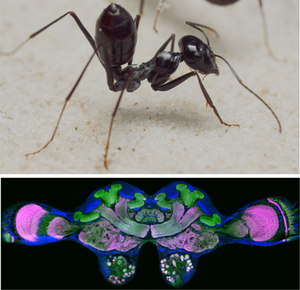Project B6 Rössler/Wehner
Title: Neuronal basis of orientation in time and space in Cataglyphis ants
Summary
Desert ants of the genus Cataglyphis are primarily visually guided central-place foragers. Their longrange spatial orientation system critically depends on polarized-skylight vision based path integration and view-based landmark guidance. This particularly applies to Cataglyphis fortis, a species that inhabits North African salt flats - almost landmark free habitats with scarce food sources. We use this highly adapted desert ant as a model to address fundamental questions related to timing of skycompass orientation at two time scales:
- Ontogenetic calibration: the ants’ natural behavioural ontogeny includes a period inside the dark nest followed by a brief transition to outside foraging in bright sunlight. We hypothesize that at this transition the polarization-vision pathway in the brain is calibrated/imprinted to the function of celestial cues specific for the time of the year and geographical position. Specifically, we ask where and when initial adjustments in the underlying neuronal circuitry take place and whether these are controlled by an age-related internal programme and/or sensory experience.
- Circadian compensation: once established polarized-skylight vision (in the context of compassbased path integration) requires compensation of the solar ephemeris function on a daily basis (table of values for the position of celestial cues at a given time). We hypothesize that this is mediated by the circadian clock (with reference to the horizon skyline as an earthbound reference) and will investigate clock-neuron networks in the brain and their interaction with the visual pathway, in particular polarization vision. The project combines quantitative behavioural experiments (both field and laboratory) with neuronal circuit and neuroendocrine analyses to address fundamental questions of ontogenetic and circadian timing aspects in spatial-cum-temporal sensory orientation essential for efficient central place foraging.

Fig 1: The desert ant Cataglyphis fortis and immunofluorescent labeling of its brain





